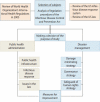Infectious disease-related laws: prevention and control measures
- PMID: 28774161
- PMCID: PMC5675986
- DOI: 10.4178/epih.e2017033
Infectious disease-related laws: prevention and control measures
Abstract
Objectives: This study examines recently revised Korean government legislation addressing global infectious disease control for public health emergency situations, with the aim of proposing more rational, effective and realistic interpretations and applications for improvement of law.
Methods: The Korea reported its first laboratory-confirmed case of Middle East Respiratory Syndrome (MERS) coronavirus on May 20, 2015. Since the first indexed case, Korean public health authorities enforced many public health measures that were not authorized in the law; the scope of the current law was too limited to cover MERS. Korea has three levels of government: the central government, special self-governing provinces, and si/gun/gu. Unfortunately, the Infectious Disease Control and Prevention Act does not designate the specific roles of each level of government, and does not state how these governmental branches should be vertically integrated in a state of emergency.
Results: When thinking about these policy questions, we should be especially concerned about introducing a new act that deals with all matters relevant to emerging infectious diseases. The aim would be to develop a structure that specifies the roles of each level of government, and facilitates the close collaboration among them, then enacting this in law for the prevention and response of infectious disease.
Conclusions: To address this problem, after analyzing the national healthcare infrastructure along with the characteristics of emerging infectious diseases, we propose the revision of the relevant law(s) in terms of governance aspects, emergency medical countermeasure aspects, and the human rights aspect.
Keywords: Epidemiology; Governance; Human rights; Infectious disease prevention and control; Middle East Respiratory Syndrome.
Conflict of interest statement
The author has no conflicts of interest to declare for this study.
Figures
References
-
- Kleczkowski BD, Roemer MI, Van Der Werff A. National health systems and their reorientation towards health for all: guidelines for policy-making. 1984 [cited 2017 Aug 28]. Available from: http://apps.who.int/iris/bitstream/10665/41638/1/WHO_PHP_77.pdf. - PubMed
-
- Ministry of Health and Welfare Basic plan for prevention and management of infectious diseases (2013-2017) [cited 2017 Aug 28]. Available from: http://www.mohw.go.kr/react/jb/sjb030301vw.jsp?PAR_MENU_ID=03&MENU_ID=03... (Korean)
-
- Choi JW, Lee JS, Kim KH, Kang CH, Yum HK, Kim Y, et al. Proposed master plan for reform of the national infectious disease prevention and management system in Korea. J Korean Med Assoc. 2015;58:723–728. (Korean)
MeSH terms
LinkOut - more resources
Full Text Sources
Other Literature Sources



